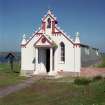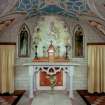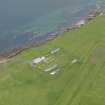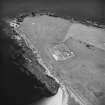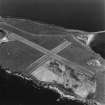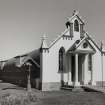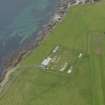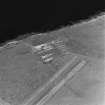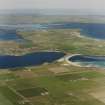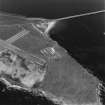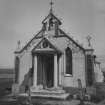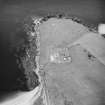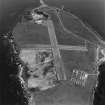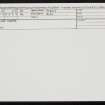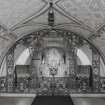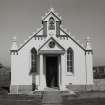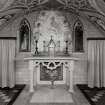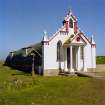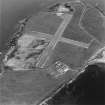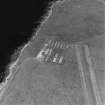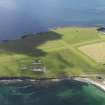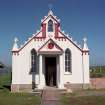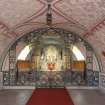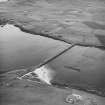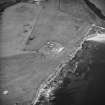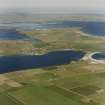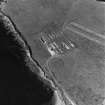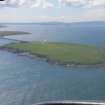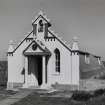Pricing Change
New pricing for orders of material from this site will come into place shortly. Charges for supply of digital images, digitisation on demand, prints and licensing will be altered.
Upcoming Maintenance
Please be advised that this website will undergo scheduled maintenance on the following dates:
Thursday, 9 January: 11:00 AM - 3:00 PM
Thursday, 23 January: 11:00 AM - 3:00 PM
Thursday, 30 January: 11:00 AM - 3:00 PM
During these times, some functionality such as image purchasing may be temporarily unavailable. We apologise for any inconvenience this may cause.
Lamb Holm, Italian Chapel
Chapel (20th Century)
Site Name Lamb Holm, Italian Chapel
Classification Chapel (20th Century)
Alternative Name(s) Scapa Flow
Canmore ID 2380
Site Number HY40SE 26
NGR HY 48829 00628
Datum OSGB36 - NGR
Permalink http://canmore.org.uk/site/2380
- Council Orkney Islands
- Parish Holm
- Former Region Orkney Islands Area
- Former District Orkney
- Former County Orkney
The Italian Chapel at Lamb Holm was created by Italian prisoners-of-war held at nearby Camp 60 during the Second World War.
Behind the bright frontispiece, two conjoined Nissen huts are oriented east-west, in keeping with ecclesiastical tradition. Inside the chapel, a 'vaulted' ceiling of painted plasterboard disguises the steel-ribbed structure of the hut. The altarpiece was painted by Domenico Chiocchetti, the principal creator of the chapel.
Information from RCAHMS (SC) 21 June 2007
HY40SE 26.00 48829 00628
HY40SE 26.01 HY 48763 00594 Statue
For (associated) prisoner-of-war camp, see HY40SE 28.
Visible on air photograph (OS 63/45/146, flown 1963).
(Undated) information in NMRS.
Double Nissen hut with barrel vaulted currugated iron roof, joined end-on is situated on the N shore of Lamb Holm. The W elevation has been given Doric columns supporting a pediment and there is a date panel at the entrance, 'A D MCMXLIV' and a pointed-arched bellcote above. Two pointed arched narrow windows flank the door.
The huts are the only surviving upstanding structure from the Italian Prisoner-of-war camp 60 which stood to the S. The concrete bases for the huts are still visible in the field to the S. The remains of the camp are visible on a RAF vertical air photograph (106G/Scot/UK137, 3014, flown 3 July 1946).
The huts were decorated internally for use as a chapel by one of the prisoners during the war.
The huts were renovated in the 1960s.
Visited by RCAHMS (DE, GS, SW), August 1999
Conservation (1960)
Domenico Chiocchetti returned to Orkney for three weeks to carry out restoration work.
Reference (1961)
A carved figure of Christ was given to the island by citizens of Chiocchetti's home town Moena.
Chapel Preservation Committee 1999
Photographic Survey (2 May 1996)
Publication Account (1996)
The ingenuity and improvisation of the Italian prisoners-of-war who had worked on the Churchill Barriers led to the creation of this small chapel dedicated to Regina Pacis, the Queen of Peace (see p.29). It was designed by Domenico Chiocchetti, an artist and church decorator in peacetime, and consists of two Nissen huts placed end-to-end with embellishments made largely from materials salvaged from the sea. The entrance has an elaborate facade with pinnacles and a bell cote, and the colourful interior is divided into nave and chancel by a beautiful wrought-iron screen. Behind the altar is a painting of the Madonna and Child, flanked by windows with painted glass, and the entire span of the vault is painted with finely detailed frescoes.
The prisoner-of-war camp was already abandoned by the time that the chapel was finished in 1945, but, outside the chapel, there is a concrete statue of St George slaying the dragon which formerly decorated the camp 'square'. Within its base is preserved a roll with the names of all the prisoners. Through the efforts of local people, the chapel was restored by its chief creator, Domenico Chiocchetti, during a three-week visit in 1960, and it retains today a very special place in Orcadian memory of the last war.
Information from ‘Exploring Scotland’s Heritage: Orkney’, (1996).
Photographic Survey (23 August 1997)
Orkney Smr Note
Chapel ingeniously improvised out of a Nissen but
embellished with scrap materials, made by Italian
prisoners-of-war quartered on Lambholm while assisting the
building of the Churchill Causeways. Now maintained by an ad-hoc
committee, has been extensively restored and is a major tourist
attraction.
Information from Orkney SMR [n.d.]





































